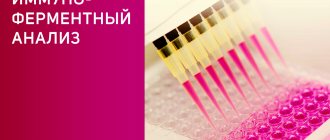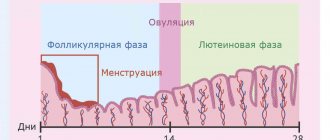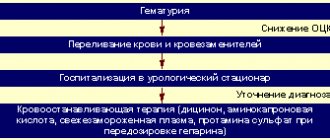Complexes with this research
Advanced male anti-aging diagnostics Advanced monitoring of key indicators in men aged 40+ RUB 33,710 Composition
Adrenogenital complex Analysis of excess male hormones in women RUB 2,560 Composition
Three important indicators for a man Diagnosis of problems of the reproductive system RUB 1,810 Composition
IN OTHER COMPLEXES
- Advanced women's anti-aging diagnostics RUB 28,680
- Advanced anti-aging diagnostics in postmenopause RUB 29,230
- Women's anti-aging diagnostics RUB 12,070
- Metabolic profile RUB 5,900
- Stress complex 4,310 RUR
Cortisol (hydrocortisone) is a steroid hormone belonging to the class of glucocorticoid hormones. Produced by the zona fasciculata of the adrenal cortex. The biological metabolite of cortisol is 6-β-hydroxycortisol, which is formed in the liver under the influence of the CYP3A4 isoenzyme, localized in the liver and in the cells of the small intestine. The main processes of biotransformation of xenobiotics, including drugs, occur in the liver with the participation of enzymes of the cytochrome P450 system, in particular the CYP3A4 isoenzyme. In clinical practice, the cortisol/cortisone ratio is used to indirectly assess the activity of the 11-hydroxysteroid dehydrogenase system (11α-HSD and 11β-HSD), and the 6-hydroxycortisol/cortisol ratio is used to determine the activity of the CYP3A4 isoenzyme. The determination of cortisol also has independent diagnostic value.
Defined parameters:
- Cortisol
- Cortisone (clinically significant in calculating the cortisol/cortisone ratio)
- 6-Hydroxycortisol
Ratios:
- Cortisol/cortisone
- 6-hydroxycortisol/cortisol
Research method
Gas chromatography-mass spectrometry (GC-MS).
Units
mcg/day (micrograms per day).
What biomaterial can be used for research?
Daily urine.
How to properly prepare for research?
- Avoid physical and emotional stress for 24 hours before the test.
- Avoid physical and emotional stress during the collection of daily urine (during the day).
General information about the study
Cortisol (hydrocortisone) is a steroid hormone belonging to the class of glucocorticoid hormones. Produced by the zona fasciculata of the adrenal cortex under the control of the hypothalamus and adrenocorticotropic hormone (ACTH), synthesized by the anterior pituitary gland. Cortisol stimulates proteolysis (the breakdown of proteins into amino acids) mainly in muscle tissue and activates gluconeogenesis in the liver (synthesis of glucose from amino acid residues).
Metabolism
The half-life of cortisol in the body is about 90 minutes. It is reversibly metabolized by the 11-hydroxysteroid dehydrogenase (11-HSD) system, which is represented by two enzymes: 11α-HSD catalyzes the conversion of cortisol to cortisone, and 11β-HSD back. Cortisone is the main metabolite of cortisol with weak glucocorticoid activity. The adrenal glands and kidneys are the main organs where cortisol inactivation occurs with the participation of 11α-HSD. Cortisone is also considered as a “temporary” depot for quickly replenishing the body’s needs for cortisol. The enzyme 11β-HSD converts inert cortisone back into biologically active cortisol. The maximum activity of 11β-HSD is observed in the liver and to a much lesser extent in adipose tissue, gonads, central nervous system and muscles. In obesity, insulin resistance, and metabolic syndrome, 11β-HSD activity in adipose tissue increases, which enhances the reconversion of cortisone to cortisol. Cortisol and cortisone are metabolized by 5β-reductase in the liver (to a lesser extent in the adrenal glands) into inactive tetrahydrocortisol and tetrahydrocortisone. The levels of cortisol and cortisone in the body depend on the activity of 5β-reductase. More than 95% of tetrahydroderivative metabolites of cortisol and cortisone form conjugates in the liver with glucuronic and sulfuric acid residues and are quickly excreted in the urine.
6-Hydrocortisol is formed from cortisol under the action of the CYP3A4 isoenzyme, localized in the endoplasmic reticulum of liver and intestinal cells. This isoenzyme, part of the cytochrome P450 system, is responsible for the metabolism of many substances of both endogenous origin (steroid hormones, lipids, bile acids) and xenobiotics, including drugs, environmental toxicants and natural compounds found in food. This isoenzyme is considered the main of all isoenzymes of the CYP family; it is found not only in the liver, but also in the prostate, mammary glands, epithelial cells of the small and large intestines, and even in brain cells. CYP3A4 metabolizes more than half of the drugs used today, including anticancer drugs, immunosuppressants, antifungals, macrolides, tricyclic antidepressants, etc. Since this isoenzyme contains a large number of substrates, changes in CYP3A4 activity often occur, caused by both drug-drug interactions and exposure xenobiotics from the environment and food (for example, natural compounds in grapefruit juice inhibit CYP3A4 activity).
Laboratory diagnostics
For diagnosis, the most informative method is the simultaneous determination of these steroids in 24-hour urine.
Determination of cortisol has independent diagnostic value.
Cortisone is an auxiliary analyte for laboratory diagnosis of adrenal pathology: for calculating the cortisol/cortisone ratio. In clinical practice, this ratio is used to indirectly assess the activity of 11α-HSD. Its increase is explained by decreased 11α-HSD activity, or increased 11β-HSD activity, or a combination of these two factors.
With a deficiency of 11β-HSD, the cortisone/cortisol ratio is greater than 1. In the absence of pathology, as a rule, it is 1:2 – 1:3. The actual reference values for cortisone in daily urine, which are given below, are approximate and their independent diagnostic value is low.
In clinical practice, the determination of the ratio of 6-hydroxycortisol and cortisol is used to determine the activity of the CYP3A4 isoenzyme, which, along with the conversion of cortisol to 6-hydroxycortisol, is involved in the metabolism of xenobiotics, including drug compounds. Tetrahydrocortisol and tetrahydrocortisone are the end products of the metabolism of cortisol and cortisone, and measuring their levels makes it possible to more accurately determine disturbances in the metabolism of this group of hormones, which perform many important functions in the body.
An increase in the tetrahydrocortisol/tetrahydrocortisone ratio is a marker of hypertensive disorders resulting from the suppression of 11-beta-hydroxysteroid dehydrogenase by pharmacological drugs or foods containing glycyrrhizic acid, or due to a genetic defect in this enzyme.
The 6-hydroxycortisol/cortisol ratio allows you to evaluate the activity of the CYP3A4 enzyme, which is part of the cytochrome P450 enzyme system, which ensures the detoxification of various compounds.
When is the study scheduled?
- Detection of acquired adrenal cortex dysfunction.
- Subclinical form of Itsenko-Cushing syndrome/disease.
- Obesity.
- Chronic renal failure.
- Differential diagnosis of adrenal cortex dysfunction.
- Impaired spermatogenesis and fertility in men.
- Hypogonadism, delayed sexual development.
- Habitual miscarriage, infertility in women.
- Polycystic ovary syndrome.
- Hormone-producing tumors of the adrenal cortex, ovaries and testicles.
- Control during treatment with glucocorticoids.
What do the results mean?
Reference values
| Cortisol, mcg/day. | 6-hydroxycortisol, mcg/day | Ratio | |||
| Age, years | Women | Men | 20-1200 | Cortisol/cortisone | 6-hydroxycortisol/cortisol |
| 3-9 | 0,15-0,5 | 2,5-22 Recommended: at least 7 | |||
| 9-13 | |||||
| 13-18 | |||||
| 18 and older | |||||
Cortisone: for calculating the cortisol/cortisone ratio only. Independent diagnostic value is low.
Clinical relevance
| Possible reasons for increased concentration | Possible reasons for the decrease in concentration | |
| Cortisol | — Itsenko-Cushing syndrome, Itsenko-Cushing disease — Pituitary dysfunction and insufficient secretion of ACTH (ectopic ACTH syndrome) — Benign and malignant formations in the adrenal glands (corticosteroma, carcinoma) — Increased thyroid function (hyperthyroidism) — Mental disorders (stress, prolonged depression) — Pregnancy - Taking sedatives (amizole, agri, miolastane, nitram, nozepam, propazine, hemiton), amphetamines, corticotropin, cortisone acetate, estrogens, ethanol (intravenous and oral), interferon gamma, methoxamine, metoclopramide, naloxone, nicotine (in smokers ), oral contraceptives, vasopressin | — Congenital insufficiency of the adrenal cortex — Pituitary gland dysfunction (hypopituitarism) — Addison's disease — Systemic diseases and pathologies of the liver (hepatitis, cirrhosis) and biliary tract — Adrenogenital syndrome with adrenal hyperplasia — Thyroid dysfunction (hypothyroidism) - The use of drugs such as prednisolone, hydrocortisone, dexamethasone, aminoglutethimide, beclomethasone, betamethasone, etomidate, ketoconazole, levodopa, lithium carbonate, methylprednisolone, metyrapone, morphine, phenytoin, trilostane, licorice root drugs |
| 6-hydroxycortisol | Decreased activity of the CYP3A4 enzyme. The consequence is a weakening of the detoxification function of the liver and intestines. | |
| Ratios | ||
| 6-hydroxycortisol/cortisol | Allows you to evaluate the activity of the CYP3A4 enzyme, which, along with the conversion of cortisol to 6-hydroxycortisol, is part of the cytochrome P450 enzyme system and is involved in the metabolism of xenobiotics, including drugs. Recommended value: at least 7. | |
| Cortisol/cortisone | In the absence of pathology, the ratio of cortisol to cortisone is usually 1:2–1:3, that is, within 0,15–0,5. Possible reasons for the increase — Subclinical form of Itsenko-Cushing syndrome — Obesity — Chronic renal failure - Taking licorice preparations containing glycyrrhizic acid, corticotropins, dexamethasone, prednisolone, barbiturates, phenytoin, mitotane, aminoglutethimide and rifampicin. | |
The interpretation of the results obtained is carried out by the doctor in conjunction with medical history, clinical data and the results of other diagnostic studies.
Detailed description of the study
Cortisol is the main hormone of the adrenal cortex, which is called the “stress hormone”. It is produced by the adrenal glands in stressful situations to improve brain function, support the nervous system and stimulate the heart.
Cortisol regulates metabolic processes, promotes the formation of glycogen and its deposition, stimulates the breakdown of fats and can increase the level of cholesterol and lipids in the blood. This hormone is necessary to maintain all systems in the human body and regulate its daily rhythms. With an excessive amount of cortisol, the production of sleep hormones, melatonin and serotonin decreases, sodium retention in the body, edema and hypokalemia is observed, internal organs suffer: adrenal glands, liver, heart and kidneys.
Cortisol enhances the vasoconstrictor effect of other hormones and increases the volume of urine excreted per day.
Cortisol has an anti-inflammatory effect, affects cellular and humoral immunity and reduces the body's susceptibility to harmful agents.
Changes in the concentration of cortisol in the blood depend on the functional activity of the adrenal glands and the state of the pituitary gland. The formation of cortisol is regulated by ACTH, the adrenocorticotropic hormone of the pituitary gland, according to the feedback principle: a decrease in cortisol levels leads to an increase in the production of ACTH. Adrenocorticotropic hormone, in turn, stimulates the production of cortisol in the adrenal glands. When cortisol levels normalize, ACTH production decreases.
An increase in cortisol levels in the body can be suspected in patients with obesity, arterial hypertension and high blood sugar. Cortisol deficiency can manifest itself as increased fatigue, weakness, apathy and weight loss.
Cortisone
The incidence and severity of side effects depend on the duration of use, the size of the dose used and the ability to comply with the circadian rhythm of the prescription.
From the endocrine system
: decreased glucose tolerance, “steroid” diabetes mellitus or manifestation of latent diabetes mellitus, suppression of adrenal function, Itsenko-Cushing syndrome (moon-shaped face, pituitary-type obesity, hirsutism, increased blood pressure, dysmenorrhea, amenorrhea, myasthenia gravis, stretch marks), delayed puberty development in children.
From the digestive system
: nausea, vomiting, pancreatitis, “steroid” gastric and duodenal ulcers, erosive esophagitis, bleeding and perforation of the gastrointestinal tract, increased or decreased appetite, flatulence, hiccups. In rare cases, increased activity of liver transaminases and alkaline phosphatase.
From the cardiovascular system
: arrhythmias, bradycardia (up to cardiac arrest); development (in predisposed patients) or increased severity of heart failure, ECG changes characteristic of hypokalemia, increased blood pressure, hypercoagulation, thrombosis. In patients with acute and subacute myocardial infarction, the necrosis focus spreads, the formation of scar tissue slows down, which can lead to rupture of the heart muscle.
From the nervous system
: delirium, disorientation, euphoria, hallucinations, manic-depressive psychosis, depression, paranoia, increased intracranial pressure, nervousness or anxiety, insomnia, dizziness, vertigo, pseudotumor of the cerebellum, headache, convulsions.
From the senses
: posterior subcapsular cataract, increased intraocular pressure with possible damage to the optic nerve, a tendency to develop secondary bacterial, fungal or viral eye infections, trophic changes in the cornea, exophthalmos.
Metabolism
: increased excretion of calcium ions, hypocalcemia, increased body weight, negative nitrogen balance (increased protein breakdown), increased sweating. Caused by mineralocorticoid activity: fluid and sodium ion retention (peripheral edema), hypernatremia, hypokalemic syndrome (hypokalemia, arrhythmia, myalgia or muscle spasm, unusual weakness and fatigue.
From the musculoskeletal system
: slower growth and ossification processes in children (premature closure of epiphyseal growth zones), osteoporosis (very rarely - pathological bone fractures, aseptic necrosis of the head of the humerus and femur), rupture of muscle tendons, “steroid” myopathy, decreased muscle mass (atrophy).
From the skin and mucous membranes
: delayed wound healing, petechiae, ecchymosis, skin thinning, hyper- or hypopigmentation, “steroid” acne, stretch marks, tendency to develop pyoderma and candidiasis.
Allergic reactions
: generalized (skin rash, itching, anaphylactic shock), local allergic reactions.
Others
: development or exacerbation of infections (the appearance of this side effect is facilitated by jointly used immunosuppressants and vaccination), leukocyturia, withdrawal syndrome.
Cortisone tablets 25 mg 80 pcs.
From the endocrine system: decreased glucose tolerance, “steroid” diabetes mellitus or manifestation of latent diabetes mellitus, suppression of adrenal function, Itsenko-Cushing syndrome (moon-shaped face, pituitary-type obesity, hirsutism, increased blood pressure, dysmenorrhea, amenorrhea, myasthenia, striae ), delayed sexual development in children. From the digestive system: nausea, vomiting, pancreatitis, “steroid” gastric and duodenal ulcers, erosive esophagitis, bleeding and perforation of the gastrointestinal tract, increased or decreased appetite, flatulence, hiccups. In rare cases, increased activity of liver transaminases and alkaline phosphatase. From the cardiovascular system: arrhythmias, bradycardia (up to cardiac arrest); development (in predisposed patients) or increased severity of heart failure, ECG changes characteristic of hypokalemia, increased blood pressure, hypercoagulation, thrombosis. In patients with acute and subacute myocardial infarction, the necrosis focus spreads, the formation of scar tissue slows down, which can lead to rupture of the heart muscle. From the nervous system: delirium, disorientation, euphoria, hallucinations, manic-depressive psychosis, depression, paranoia, increased intracranial pressure, nervousness or anxiety, insomnia, dizziness, vertigo, pseudotumor of the cerebellum, headache, convulsions. From the senses: posterior subcapsular cataract, increased intraocular pressure with possible damage to the optic nerve, a tendency to develop secondary bacterial, fungal or viral eye infections, trophic changes in the cornea, exophthalmos. From the metabolic side: increased excretion of calcium ions, hypocalcemia, increased body weight, negative nitrogen balance (increased protein breakdown), increased sweating. Caused by mineralocorticoid activity: fluid and sodium ion retention (peripheral edema), hypernatremia, hypokalemic syndrome (hypokalemia, arrhythmia, myalgia or muscle spasm, unusual weakness and fatigue). From the musculoskeletal system: slowing of growth and ossification processes in children (premature closure of the epiphyseal growth zones), osteoporosis (very rarely - pathological bone fractures, aseptic necrosis of the head of the humerus and femur), rupture of muscle tendons, “steroid” myopathy, decreased muscle mass (atrophy). From the skin and mucous membranes: delayed wound healing, petechiae, ecchymoses, thinning of the skin, hyper- or hypopigmentation, “steroid” acne, stretch marks, a tendency to develop pyoderma and candidiasis. Allergic reactions: generalized (skin rash, itching, anaphylactic shock), local allergic reactions. Other: development or exacerbation of infections (the appearance of this side effect is facilitated by jointly used immunosuppressants and vaccination), leukocyturia, withdrawal syndrome.
Pharmacological properties
Hydrocortisone in the composition of the drug is a natural glucocorticosteroid. It has anti-inflammatory, antiallergic, antipruritic and anti-edematous effects. Stabilizes cellular (subcellular) membranes of mast cells, lysosome membranes. Inhibits the alteration phase, reduces cellular infiltrates of inflammation, suppresses the migration of inflammatory mediators to the site of the lesion. Reduces the binding of immunoglobulins and receptors on the cell surface, blocks the synthesis and release of cytokines from macrophages and lymphocytes. Reduces the synthesis of arachidonic acid metabolites (prostaglandins, leukotrienes, thromboxane). Inhibits the exudation reaction, reduces capillary permeability. Levels the severity of the immunological response. Induces the formation of lipocortins with anti-edematous activity. It exhibits antimetabolic effect, inhibits the proliferation of connective tissue, collagen deposits, and scarring. When used in therapeutic doses, it has almost no systemic effect.
References
- Yudina, T.Yu., Basenko, N.V., Ustinova, N.V. etc. Advantages of determining cortisol in saliva for identifying initial dysfunctions of the adrenal glands and pituitary gland. Healthcare of the Far East, 2019. - No. 2(80). — P. 38-40.
- Druzhkova, T.A., Pochigaeva, K.I., Gekht, A.B. et al. Assessment of free cortisol in saliva: correlation with serum cortisol in patients with depressive disorders. Neurochemistry, 2015. - No. 4. - P. 334.
- Goncharov, N.P., Kaimya, G.V., Marova, E.I. et al. Use of an ultrasensitive method for determining biologically active free cortisol in saliva to assess the glucocorticoid function of the adrenal cortex. Problems of endocrinology, 2008. - No. 3. - P. 27-35.
- Blair, J., Adaway, J., Keevil, B. et al. Salivary cortisol and cortisone in the clinical setting. Current opinion inendocrinology, diabetes and obesity, 2021. - Vol. 24(3). — P. 161-168.









